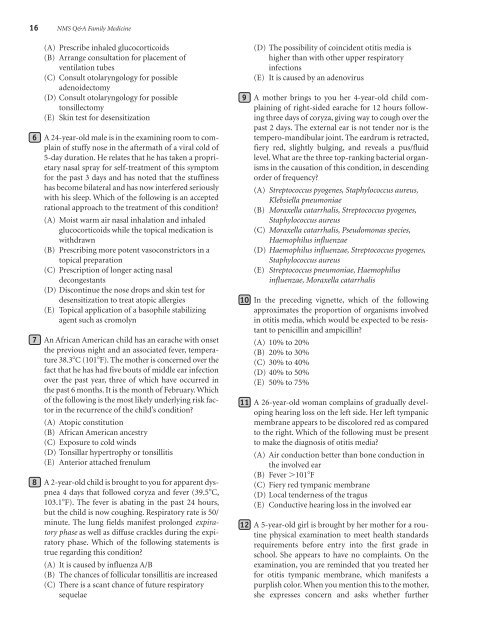NMS Q&A Family Medicine
NMS Q&A Family Medicine
NMS Q&A Family Medicine
- No tags were found...
You also want an ePaper? Increase the reach of your titles
YUMPU automatically turns print PDFs into web optimized ePapers that Google loves.
16 <strong>NMS</strong> Q&A <strong>Family</strong> <strong>Medicine</strong>(A) Prescribe inhaled glucocorticoids(B) Arrange consultation for placement ofventilation tubes(C) Consult otolaryngology for possibleadenoidectomy(D) Consult otolaryngology for possibletonsillectomy(E) Skin test for desensitization6 A 24-year-old male is in the examining room to complainof stuffy nose in the aftermath of a viral cold of5-day duration. He relates that he has taken a proprietarynasal spray for self-treatment of this symptomfor the past 3 days and has noted that the stuffinesshas become bilateral and has now interfered seriouslywith his sleep. Which of the following is an acceptedrational approach to the treatment of this condition?(A) Moist warm air nasal inhalation and inhaledglucocorticoids while the topical medication iswithdrawn(B) Prescribing more potent vasoconstrictors in atopical preparation(C) Prescription of longer acting nasaldecongestants(D) Discontinue the nose drops and skin test fordesensitization to treat atopic allergies(E) Topical application of a basophile stabilizingagent such as cromolyn7 An African American child has an earache with onsetthe previous night and an associated fever, temperature38.3C (101F). The mother is concerned over thefact that he has had five bouts of middle ear infectionover the past year, three of which have occurred inthe past 6 months. It is the month of February. Whichof the following is the most likely underlying risk factorin the recurrence of the child’s condition?(A) Atopic constitution(B) African American ancestry(C) Exposure to cold winds(D) Tonsillar hypertrophy or tonsillitis(E) Anterior attached frenulum8 A 2-year-old child is brought to you for apparent dyspnea4 days that followed coryza and fever (39.5C,103.1F). The fever is abating in the past 24 hours,but the child is now coughing. Respiratory rate is 50/minute. The lung fields manifest prolonged expiratoryphase as well as diffuse crackles during the expiratoryphase. Which of the following statements istrue regarding this condition?(A) It is caused by influenza A/B(B) The chances of follicular tonsillitis are increased(C) There is a scant chance of future respiratorysequelae(D) The possibility of coincident otitis media ishigher than with other upper respiratoryinfections(E) It is caused by an adenovirus9 A mother brings to you her 4-year-old child complainingof right-sided earache for 12 hours followingthree days of coryza, giving way to cough over thepast 2 days. The external ear is not tender nor is thetempero-mandibular joint. The eardrum is retracted,fiery red, slightly bulging, and reveals a pus/fluidlevel. What are the three top-ranking bacterial organismsin the causation of this condition, in descendingorder of frequency?(A) Streptococcus pyogenes, Staphylococcus aureus,Klebsiella pneumoniae(B) Moraxella catarrhalis , Streptococcus pyogenes,Staphylococcus aureus(C) Moraxella catarrhalis, Pseudomonas species,Haemophilus influenzae(D) Haemophilus influenzae, Streptococcus pyogenes,Staphylococcus aureus(E) Streptococcus pneumoniae, Haemophilusinfluenzae, Moraxella catarrhalis10 In the preceding vignette, which of the followingapproximates the proportion of organisms involvedin otitis media, which would be expected to be resistantto penicillin and ampicillin?(A) 10% to 20%(B) 20% to 30%(C) 30% to 40%(D) 40% to 50%(E) 50% to 75%11 A 26-year-old woman complains of gradually developinghearing loss on the left side. Her left tympanicmembrane appears to be discolored red as comparedto the right. Which of the following must be presentto make the diagnosis of otitis media?(A) Air conduction better than bone conduction inthe involved ear(B) Fever 101F(C) Fiery red tympanic membrane(D) Local tenderness of the tragus(E) Conductive hearing loss in the involved ear12 A 5-year-old girl is brought by her mother for a routinephysical examination to meet health standardsrequirements before entry into the first grade inschool. She appears to have no complaints. On theexamination, you are reminded that you treated herfor otitis tympanic membrane, which manifests apurplish color. When you mention this to the mother,she expresses concern and asks whether further
















